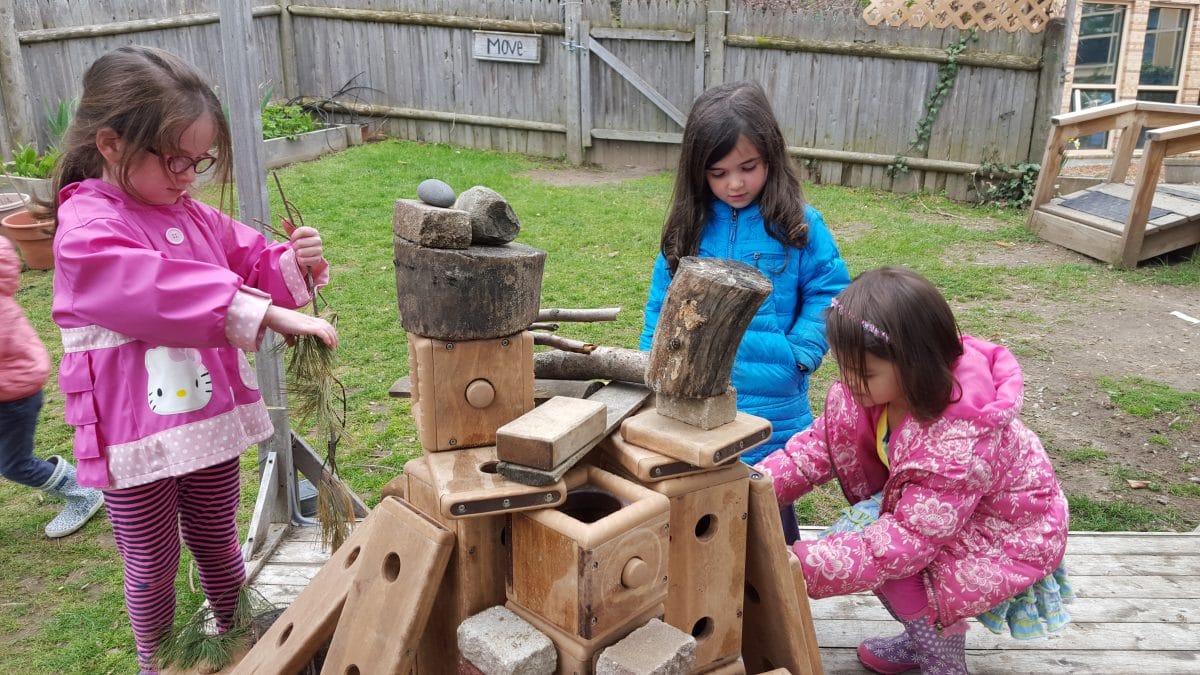Kat Gets It

Last week we had a glimpse of how we can work with children outdoors, through the eyes of David and Frances Hawkins. An adult and a child are both interested in the subject of the child’s exploration. The adult has developed (or renewed) her ability to “mess about” playfully herself. The child has the freedom of time to “mess about” in his play, exploring different ideas, trying out multiple options. For example, a young boy is trying to divert a stream of water into taking a new direction. Which materials are best to use in blocking the stream’s original path? The adult and child later review the experience, “unpacking” it, and brainstorm how it can be enlarged into further “play” and deeper learning.
Free play in a Nature Explore classroom is an ideal setting for this kind of learning. Many teachers have told us that play in their outdoor classroom requires reduced vigilance and monitoring compared to that on a traditional playground. They are freer to engage directly with children at play. When the child has sufficient time to “mess about” while exploring, the teacher may have the relaxed time to leverage the learning she sees. We can see why so many teachers have said that their time in the outdoor classroom is a high point of their day.
At the Temple Shalom Nursery School in West Newton, Massachusetts, I recently met a teacher who hadn’t studied David and Frances. Yet she puts their ideas into practice daily during her intuitive work with children.
Kat Horion’s profound love of nature began during her childhood, on a farm in Spain. By the age of four, she was delivering eggs to a nearby farm, and stopping for mini-adventures on the way back. She understands the self-directed “messing about” play of her students because that was her childhood play.
In fact, many of Kat’s insights were so concisely and elegantly expressed during our interview, that I’ll just step out of the way and let her speak.
On the highlight of her work in the Nature Explore Classroom:
“My biggest highlight here is the opportunity for children to show me what they are interested in, also for me to assess what they have already learned. When we get outside it’s so open and so freeing that you can find the quiet area or the loud area as you see fit. And you can’t when you are indoors. So you see the child who goes into water because they want the sensory experience of water, and you see the child going to water because they like the engineering aspect of building, of seeing the water tunnel something through dirt. By watching them going there on their own, without my saying ‘this is what we are going to do today’ I automatically get to see where this child is coming from and I have this really amazing window into how they are going to learn, when and if I do take them indoors.”
On how outdoor play can enhance executive function and skill development that is usually taught indoors:
“When you’re outside, the goal of play is driven by child, and I think that inspires them to really want to delve into it. To them, it’s extremely open-ended. There’s a lot that has to happen on-the-fly. And there’s a lot of readjustments. And there’s a lot of sense that, if you are uncomfortable you have to adjust, and you have to make it work.
If you find a stick of different sizes you have to change how you grip the stick. If it’s particularly slippery, or slimy, or you want to stack it you always have to be adjusting how your body is manipulating these things.
A lot of these shapes echo things you find out in the real world; pencils, pens. Things that you hold are really echoed in nature. When you’re in nature, you have to adjust. When you come in to a traditional classroom and you grip a pencil, and you want to correct your grip—in the traditional sense we’re teaching the child what the right grip is. But if we’ve come from an outdoor curriculum, if we’ve come from investigative play then they already know that if something feels uncomfortable, if something’s not working, ‘I should readjust. I should find the way this is going to work.’
So they’re automatically going to seek out that correct pencil grip, because, they’ve built up the strength in their hands from playing with these things and climbing and gripping. They’re familiar with the shape because sticks come in all sizes and shapes, like pens markers and crayons come in all different sizes. And they’re used to this idea that ‘if I want this to work for me, I have to adjust how I hold it.’ They’re able to troubleshoot for themselves rather than to continuously hold something the wrong way.”
Here, Kat brilliantly shows us the answer to the epidemic problem posed in the post “GET A GRIP!” She shows us that the child develops fine motor skills generalizable to “real world” skills naturally during outdoor play. Equally importantly, he develops the intuitive executive function that tells him how to problem-solve the task of holding a crayon.
Kat’s having messed about in nature as a child allows her to see deeply into the learning happening all around her in Temple Shalom’s Nature Explore Classroom. As she participates in children’s happy play, she understands levels of learning and meaning that allow her to scaffold their experience. Kat’s wisdom and perceptions reflect her eleven years of experience teaching there, and her four years of working in the outdoor classroom. Her enthusiasm, that I saw both outdoors and during our interview, was that of a fresh, new teacher. Kat is vitally interested in what the children are interested in, and, like them, she is a continual learner.
David and Frances Hawkins remained perpetually refreshed by their time with children. Photos show their excited and engaged expressions, even late in their lives, as they “worked” with children. And people interested them; all kinds of people. They were famous for chatting at length with a broad range of people in their Boulder, Colorado living room; from educators, to neighborhood children, to the man painting their house. I think David, Frances and Kat would have had a lot to talk about.

